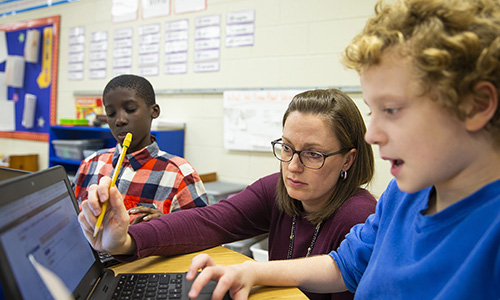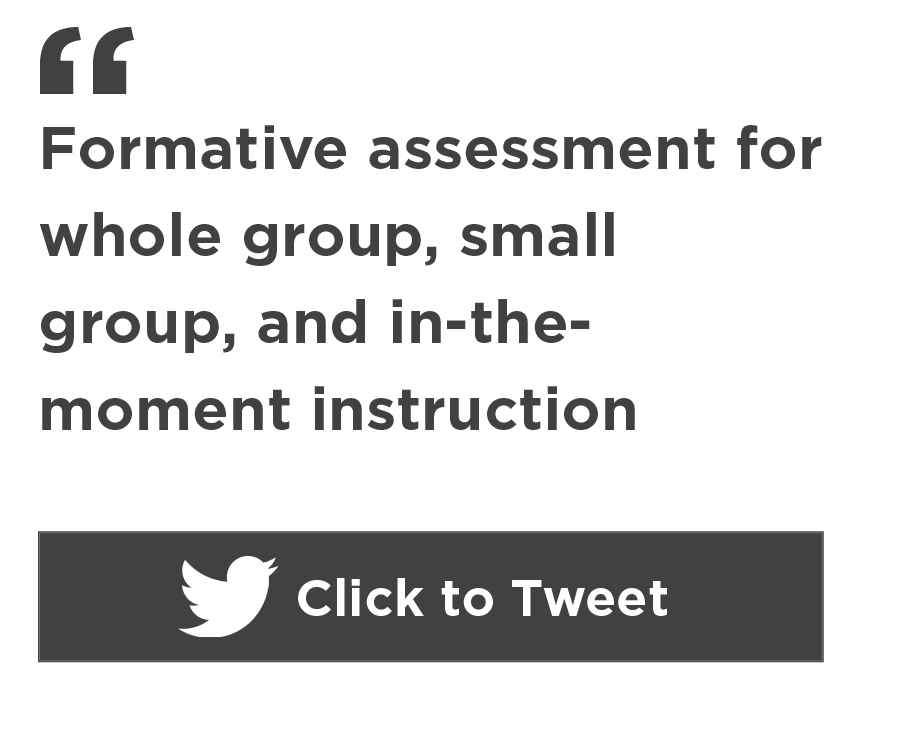
When I was in the classroom, I felt skilled using data. My students set daily personal goals, we had learning targets based on our data, and students had assessment goals. I often taught whole-group lessons, though, and thinking back, I wonder why. How did I know all the students I was delivering whole-group learning to needed that particular lesson? I didn’t. Formative assessment could have helped me.
After I left teaching, I spent time learning more about formative assessment. I realize now that I struggled with my understanding of delivering and analyzing formative assessments. I let my curriculum map determine what I taught instead of my students’ data. While there’s nothing I can do about the past, I hope that by sharing what I’ve learned, I can help you in your classroom today. Knowing how to use formative assessment effectively can inform your whole-group, small-group, and in-the-moment instruction and help you meet students where they are.
Reminder: What formative assessment is (and isn’t)
NWEA uses the following definition of “formative assessment,” adapted with permission from the Council of Chief State School Officers (CCSSO): “Formative assessment is a planned, ongoing process used by all students and teachers during learning and teaching to elicit and use evidence of student learning to improve student understanding of intended disciplinary learning outcomes and support students to become self-directed learners.”
Knowing how to use formative assessment effectively can inform your whole-group, small-group, and in-the-moment instruction and help you meet students where they are.
The words “planned, ongoing process” really stand out to me. There are moments where formative assessment is very intentional, or planned. You decide ahead of time to have an exit ticket at the end of every unit, for example. There are other opportunities where formative assessment is more spontaneous, where you realize there’s a disconnect with your students and you pause to explore why. After multiple quizzical looks from your kids, for example, you stop, ask a specific question related to your lesson, and have them answer using a thumbs-up for “yes” or thumbs-down for “no.”
While the definition doesn’t spell this out explicitly, it’s important to remember that formative assessment should not be graded. Its sole purpose is to increase your understanding so you can adjust your teaching. It’s never about penalizing kids for what they don’t know yet.
Tip #1: Use formative assessment to prepare for whole-group instruction
There is a time and a place for whole-group learning. Whole-group instruction is good for introducing new concepts and encouraging whole-class engagement. (For ideas on how to get kids excited to learn together, read “The best whole-group engagement strategies.”) Typically, whole-group instruction is targeted toward the average student in your class.
Data can provide insight into what you can teach in a whole-group setting. Using formative assessment at the end of a previous day’s lesson or at the start of a new lesson will allow you to see what your students already know about the standard you have targeted to teach. Consider using an exit or entrance ticket, for example.
The Teacher Toolkit walks you through how to use entrance tickets in your classroom. Start by having a question on the board related to the day’s learning. Allow yourself time to review the data you gather before proceeding to the whole-group lesson. You may find you have misconceptions about what your students know or that there are things they’ve misunderstood that you can address before beginning. When reviewing your formative assessment data, you may also find that what you thought should have been a whole-group lesson may need to be taught in small groups instead. What would tip you off to this? A wide array of answers proving a big range of differing abilities.
Tip #2: Let formative assessment data guide small-group work
Like my colleague Tami Hunter mentioned in her post “How to use flexible grouping remotely,” “Using flexible grouping strategies can be a great way to keep kids engaged in learning, empower students to own their learning, increase understanding through collaboration, and allow for social connections.” To be flexible, your small groups should be fluid and change frequently based on the standard you are working on and on your formative assessment data.
Formative assessment […] gives you the information you need to make instructional decisions based on exactly where students are, and it helps students have buy-in and ownership of their learning.
Small groups allow you to provide scaffolding based on where your students are. You can specifically target your lesson based on the needs of the students in that group. Your instruction will vary depending on which group you are working with and what level they are on. With some groups, you will need to help the students reach the grade-level expectation of a standard by filling gaps in previous skills. Other groups may be right on target and able to learn the new standard with ease. Some groups may have already mastered the standard you’re on and are ready to explore it more deeply or even move on to the next standard.
By providing this targeted attention to student learning needs you can help students grow and be empowered in their learning paths. While working with small groups you can also differentiate seat work or centers that are not teacher directed. Work groups could have a designated tub or folder with assignments that are targeted to meet students’ learning needs, for example. This does take more planning up front, but if you have planning or data conversations with your grade-level teams, you can plan these varied tasks together and share the load.
Tip #3: Wield formative assessment feedback to make in-the-moment adjustments
Whether you’re teaching the whole class or have broken into groups, you’ll have a multitude of opportunities to adjust your instruction—right before, during, or immediately after a lesson—based on the needs of your students. There are several simple strategies you can try right away to target your instruction and help students grow academically. Here are some examples of formative assessment techniques and when to use them.
Right before a lesson
- Standards check-in. I have used a standards check-in in kindergarten through middle school and wrote more about it in a previous post. Start by posting the lesson’s standard on a chart. Give each student a colored sticky note and tell them to write their name. Ask students to rate how they feel about the standard before they get started. This will help you create the learning target based on the standard as well as develop success criteria. It is also good to conduct another check at the end of the lesson to see if students have progressed in their understanding of the standard.
- Pre-assessment. This type of assessment is given at the start of a unit or lesson to see what students know, so you can decide how to address learning needs before beginning the lesson. I encourage you to read this blog post to learn more.
During a lesson
- Questioning. How you ask questions in your classroom can be a way of formatively assessing. Be intentional about planning your questions before lessons and make sure the questions you ask are higher order and train the brain to think deeply. Achieve the Core explains the purpose of developing questions to make meaning in their article “Creating and sequencing text-dependent questions to support English language learners” (note that their tips are useful for all students). Math teacher and trainer Craig Barton digs into this, too, in his article “What is a diagnostic question?”
- All-student response systems. Having all students give you feedback at once can give you insight into how students are processing material as they’re receiving it. I really like Emerging Ed Tech’s article “Top 5 student response systems that work on multiple platforms.” Want to try a response system that’s lower tech? Ask students to use whiteboards and hold them up to answer questions during a lesson, or have them use hand signals.
Immediately after a lesson
- Metacognition. When students are aware of their thinking throughout a lesson, they’re practicing metacognition, something that helps them process the material and better understand how they think. End a lesson by having students reflect on what—and how—they learned. This practice can help them retain more of the material.
- Exit ticket. While entrance tickets are given at the start of a lesson, exit tickets are given at the end. There are several ways to use exit tickets both virtually and on paper, as demonstrated by We Are Teachers.
Never stop learning
Formative assessment empowers both teachers and students. It gives you the information you need to make instructional decisions based on exactly where students are, and it helps students have buy-in and ownership of their learning. To learn more about how to make formative assessment a bigger part of your practice, download Making it work: How formative assessment can supercharge your practice.





